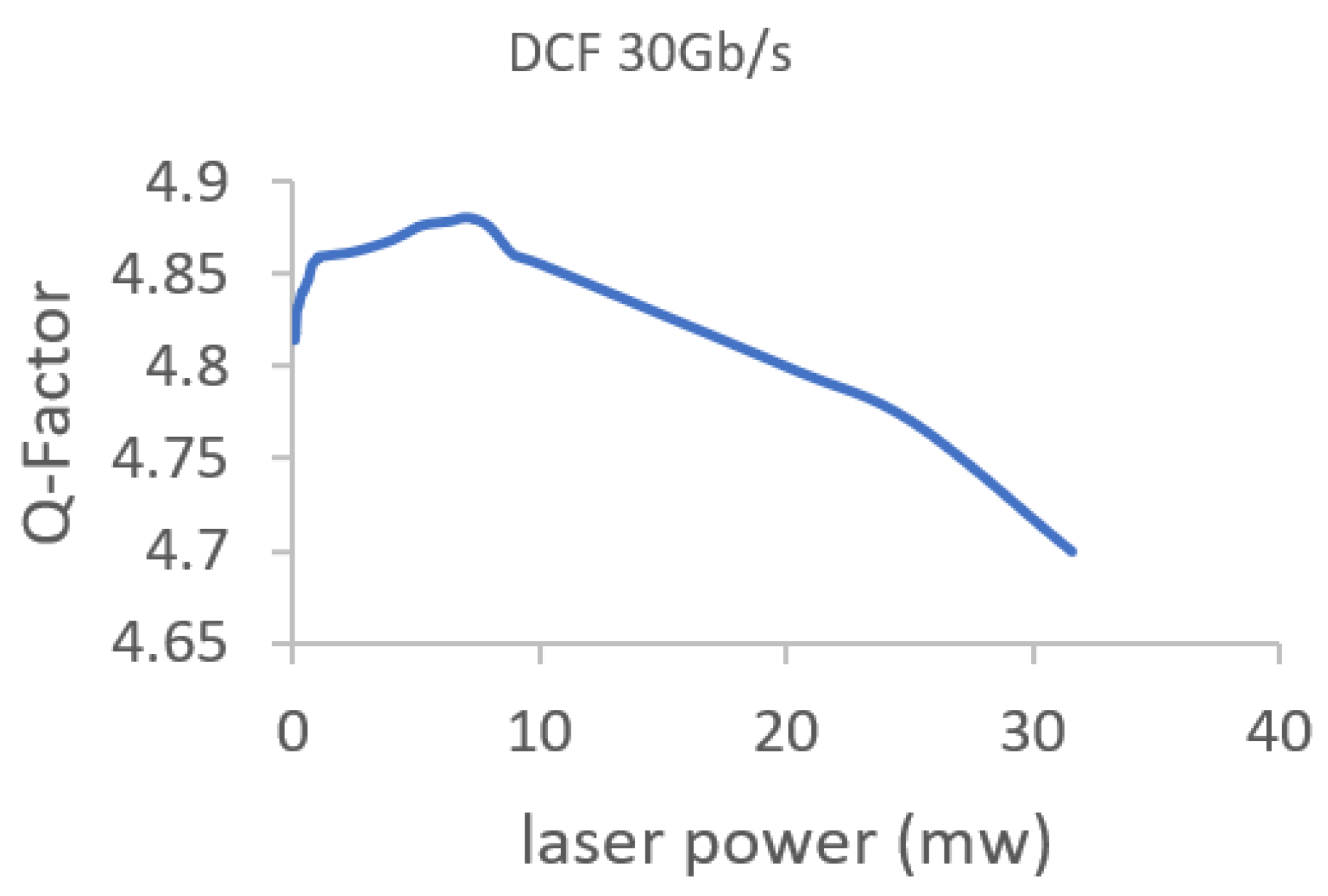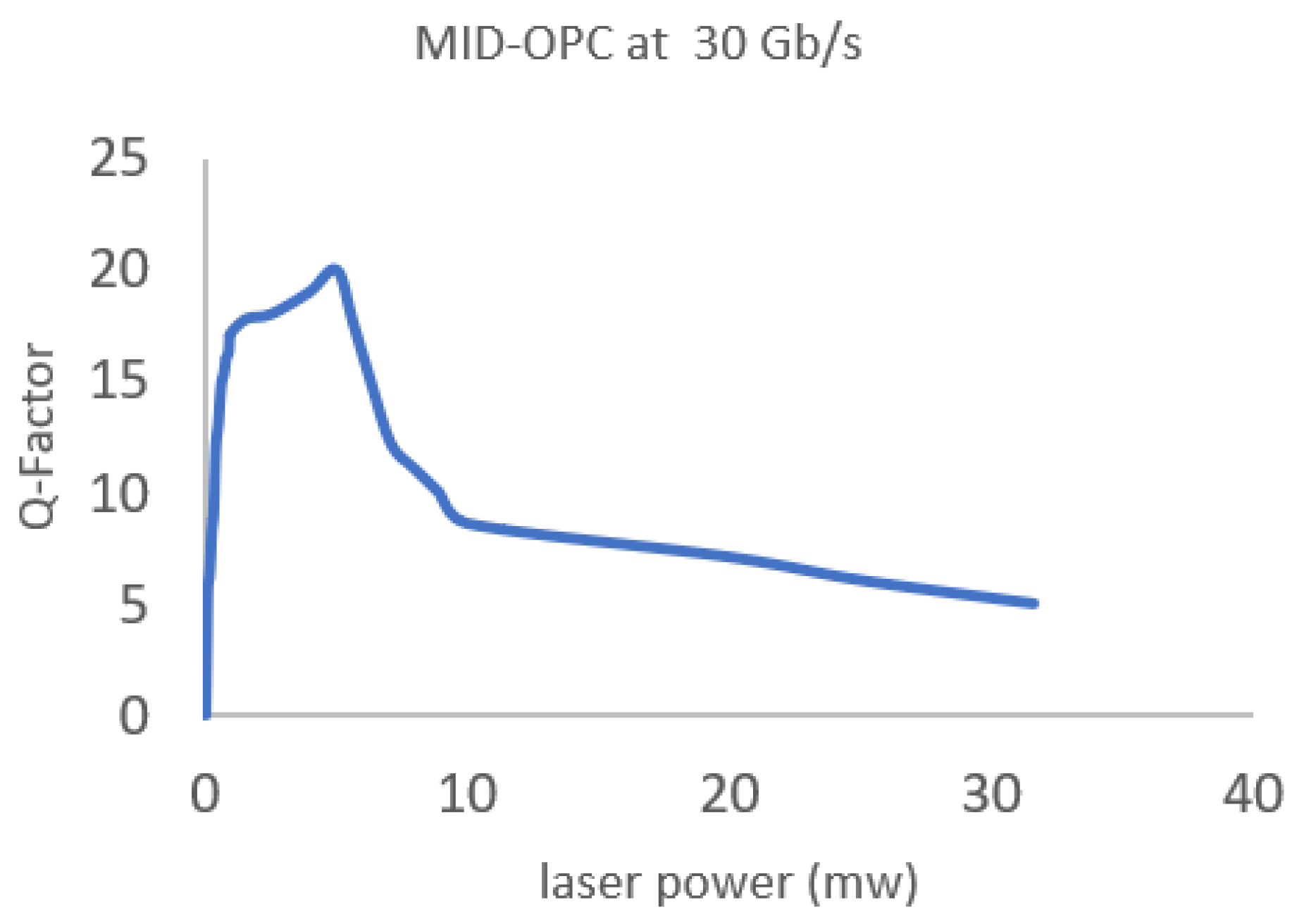Hybrid Spectrum Inversion and Dispersion Compensation for Mitigating Fiber Losses in Optical Systems †
Abstract
1. Introduction
2. Methods
2.1. Power Effect on Refractive Index
2.2. Methods of Compensation
2.2.1. Classical Dispersion Compensation
2.2.2. Optical Phase Conjugation
2.3. Mathematical Models
- Nonlinear phase shift: The nonlinear phase shift experienced when passing through a glass fiber is represented by the following equation [11]:
- Nonlinear factor: The nonlinear factor is described by the equation [12]:
- Multi-signal phase change: Cross-phase shifting occurs when the power of one laser influences the phase change of another laser signal. Specifically, in a nonlinear medium like a Kerr medium, the change in a light beam’s optical phase is caused by its interaction with another light beam. This phenomenon is known as cross-phase modification.The extent of these changes is influenced by the manipulation of other channels in a wavelength division multiplexing system and can be attributed to variations in the material’s refraction coefficient [15].
3. Results and Discussion
3.1. Compensation Using DCF
3.2. Compensation Using MID-OSI
3.3. Performance Evaluation
4. Conclusions
Author Contributions
Funding
Institutional Review Board Statement
Informed Consent Statement
Data Availability Statement
Conflicts of Interest
References
- Sugumaran, S.; Bhura, R.; Sagar, U.; Arulmozhivarrman, P. Performance analysis of FWM efficiency and Schrodinger equation solution. Int. J. Eng. Technol. (IJET) 2013, 5, 1666–1673. [Google Scholar]
- Tahar, J.; Hadj, B. Theoretical and simulation approaches for studying compensation strategies of nonlinear effects digital lightwave links using DWDM technology. J. Comput. Sci. 2007, 3, 887–893. [Google Scholar] [CrossRef]
- Surachet, K. Modeling and Analysis of the Effects of Impairments in Fiber Optic Links. Ph.D. Thesis, Virginia Tech, Blacksburg, VA, USA, 1999. [Google Scholar]
- Ros, F.D.; Yankov, M.P.; da Silva, E.P.; Lillieholm, M.; Kaminski, P.M.; Guan, P.; Hu, H.; Clausen, A.T.; Galili, M.; Oxenløwe, L.K. Nonlinearity compensation through optical phase conjugation for improved transmission reach/rate. In Proceedings of the 2018 20th International Conference on Transparent Optical Networks (ICTON), Bucharest, Romania, 1–5 July 2018; IEEE: New York, NY, USA, 2018; pp. 1–2. [Google Scholar]
- Eliasson, H.; Johannisson, P.; Karlsson, M.; Andrekson, P.A. Mitigation of nonlinearities using conjugate data repetition. Opt. Express 2015, 23, 2392–2402. [Google Scholar] [CrossRef] [PubMed]
- Xiaosheng, X.; Shiming, G.; Yu, T.; He, Y.; Changxi, Y. The effect of optical phase conjugation on inter-and intra-channel nonlinearities in ultrahigh-speed transmission systems. In Optical Transmission, Switching, and Subsystems III; SPIE: Shanghai, China, 2005; Volume 6021, pp. 759–767. [Google Scholar]
- Cristiani, I.; Minzioni, P.; Degiorgio, V.; Marazzi, L.; Martinelli, M.; Langrock, C.; Fejer, M.M. Compensation of nonlinear effects in optical communication systems through phase-conjugation. In Proceedings of the 2009 IEEE LEOS Annual Meeting Conference Proceedings, Belek-Antalya, Turkey, 4–8 October 2009; IEEE: New York, NY, USA, 2009; pp. 751–752. [Google Scholar] [CrossRef]
- Cartledge, J.C.; Guiomar, F.P.; Kschischang, F.R.; Liga, G.; Yankov, M.P. Digital signal processing for fiber nonlinearities. Opt. Express 2017, 25, 1916–1936. [Google Scholar] [CrossRef] [PubMed]
- Gonzalez-Herraez, M.; Sylvestre, T. Nonlinear Effects in Optical Fibers. In Advanced Fiber Optics; Wiley: Hoboken, NJ, USA, 2011; pp. 145–170. [Google Scholar] [CrossRef]
- Abbas, A.S. Mitigation of Distortion in WDM Systems Based on Optical Phase Conjugation. Ph.D. Thesis, Institute of Laser for Postgraduate Studies, University of Baghdad, Baghdad, Iraq, 2017. [Google Scholar]
- Kurtinaitis, A.; Ivanauskas, F. Finite difference solution methods for a system of the nonlinear Schrödinger equations. Nonlinear Anal. Model. Control 2004, 9, 247–258. [Google Scholar] [CrossRef]
- Soman, S.K.O. A tutorial on fiber Kerr nonlinearity effect and its compensation in optical communication systems. J. Opt. 2021, 23, 123502. [Google Scholar] [CrossRef]
- Andersen, T.V. Applications of Nonlinear Optics and Optical Fibers. Ph.D. Thesis, Department of Physics and Astronomy & NKT Academy, University of Aarhus, Aarhus, Denmark, 2006. [Google Scholar]
- Wang, J.; Du, Y.; Liang, C.; Li, Z.; Fang, J. Performance Evaluation of Highly Nonlinear Fiber (HNLF) Based Optical Phase Conjugation (OPC) in Long Haul Transmission of 640 Gbps 16-QAM CO-OFDM. Photonics 2021, 8, 45. [Google Scholar] [CrossRef]
- Toulouse, J. Optical nonlinearities in fibers: Review, recent examples, and systems applications. J. Light. Technol. 2005, 23, 3625–3641. [Google Scholar] [CrossRef]
- Supe, A.; Porins, J. Methods for estimation of optical fiber non-linearity using self-phase modulation effect. Latv. J. Phys. Tech. Sci. 2011, 48, 29–40. [Google Scholar] [CrossRef]
- Arnoldus, H.F.; George, T.F. Theory of optical phase conjugation in Kerr media. Phys. Rev. A 1995, 51, 4250–4263. [Google Scholar] [CrossRef] [PubMed]



Disclaimer/Publisher’s Note: The statements, opinions and data contained in all publications are solely those of the individual author(s) and contributor(s) and not of MDPI and/or the editor(s). MDPI and/or the editor(s) disclaim responsibility for any injury to people or property resulting from any ideas, methods, instructions or products referred to in the content. |
© 2024 by the authors. Licensee MDPI, Basel, Switzerland. This article is an open access article distributed under the terms and conditions of the Creative Commons Attribution (CC BY) license (https://creativecommons.org/licenses/by/4.0/).
Share and Cite
Abbas, Z.A.; Murdas, I.A.; Abbas, T.M. Hybrid Spectrum Inversion and Dispersion Compensation for Mitigating Fiber Losses in Optical Systems. Eng. Proc. 2023, 59, 208. https://doi.org/10.3390/engproc2023059208
Abbas ZA, Murdas IA, Abbas TM. Hybrid Spectrum Inversion and Dispersion Compensation for Mitigating Fiber Losses in Optical Systems. Engineering Proceedings. 2023; 59(1):208. https://doi.org/10.3390/engproc2023059208
Chicago/Turabian StyleAbbas, Zainab A., Ibrahim A. Murdas, and Talib M. Abbas. 2023. "Hybrid Spectrum Inversion and Dispersion Compensation for Mitigating Fiber Losses in Optical Systems" Engineering Proceedings 59, no. 1: 208. https://doi.org/10.3390/engproc2023059208
APA StyleAbbas, Z. A., Murdas, I. A., & Abbas, T. M. (2023). Hybrid Spectrum Inversion and Dispersion Compensation for Mitigating Fiber Losses in Optical Systems. Engineering Proceedings, 59(1), 208. https://doi.org/10.3390/engproc2023059208





